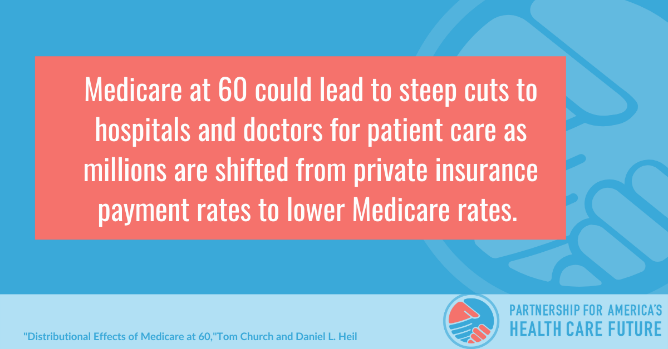New Report: ‘Medicare at 60’ Could Create Higher Costs and Threaten Access to Health Care For Americans

WASHINGTON – As some policymakers discuss proposals such as “Medicare at 60,” which would open seniors’ Medicare up to younger Americans, a new report provides evidence of the potentially unaffordable costs and negative consequences for patients and health care providers.
The report by Tom Church and Daniel L. Heil, which was supported by the Partnership for America’s Health Care Future, finds that under “Medicare at 60,” expanding the Medicare eligibility age to 60 would likely lead to large cuts for health care providers for patient care, while simultaneously increasing federal deficits.
The report’s authors found Medicare at 60 could threaten access to high-quality care for millions of Americans and warn of other potential consequences, including increased taxes, higher health insurance premiums, and a potentially devastating impact to the federal deficit.
Creating Unaffordable New Costs, Tax Increases, & Higher Deficits
- In an earlier analysis, Chen, Church, and Heil (2021) estimated that under Medicare at 60, the 10-year federal deficits would rise by $394 billion before accounting for interest costs.
- Today, Church and Heil find that lowering the Medicare eligibility age to 60 would add $42.6 billion to the federal deficit in 2023 and increase 10-year deficits by as much as $452 billion (excluding interest costs).
Threatening Access To Quality Health Care
- Hospitals and physicians could face steep cuts as millions are shifted from private insurance payment rates to lower Medicare rates.
- If Medicare at 60 were enacted for 2023, aggregate payments for hospitals and doctors would fall by $15.1 billion under the projected current-law rates.
- Payments for inpatient hospital services would fall by $12.3 billion in 2023 while payments for physician and other provider services would decline by $2.9 billion.
- Payments for inpatient hospital services in 2042 would fall by $21 billion and revenue for physician and other providers services would fall by $35.5 billion (in real 2022 dollars).
- Reductions in inpatient hospital service payments from Medicare at 60 could reduce annual profits by about 25 percent for the median hospital and by even larger amounts for hospitals with below-average margins.
- Medicare at 60 would have particularly large effects per enrollee for hospitals in Wisconsin, Washington, and Colorado, due to interstate rates paid by private insurance versus Medicare.
- Medicare at 60 brings an unavoidable trade-off between revenue cuts to physicians and hospitals or higher costs to taxpayers (through higher federal deficits).
- These potentially unsustainable cuts could mean lower quality and less access to care for the current Medicare-eligible population.
Increasing Current Health Insurance Premiums
- Over one-third of ACA marketplace enrollees would see their combined premium and out-of-pocket payments rise under the proposal, while gaining few additional benefits.
- Medicare at 60 poorly targets those most in need of assistance. The likely winners of the new policy would include many high-income individuals.
- The ACA participants most likely to be made worse off by Medicare at 60 are those with incomes between 135 to 250 percent of the poverty line.
- The Medicare at 60 eligible population is in fact far more likely to have family incomes above 400 percent of the Census poverty thresholds.
- Gross Medicare spending would rise by $1.2 trillion over the 10-year window.
Our current health care system is working to expand access to affordable, high-quality health coverage and care. According to the Department of Health & Human Services, during the Open Enrollment Period from November 1, 2021 – January 15, 2022, 5.8 million people gained new coverage under our current system. Rather than creating unaffordable, new government-controlled health insurance systems, like Medicare at 60, policymakers should continue to build on and improve what’s working in health care.
- To read the full report by Tom Church and Daniel L. Heil, CLICK HERE.
- To learn more about the Partnership for America’s Health Care Future, CLICK HERE.
###